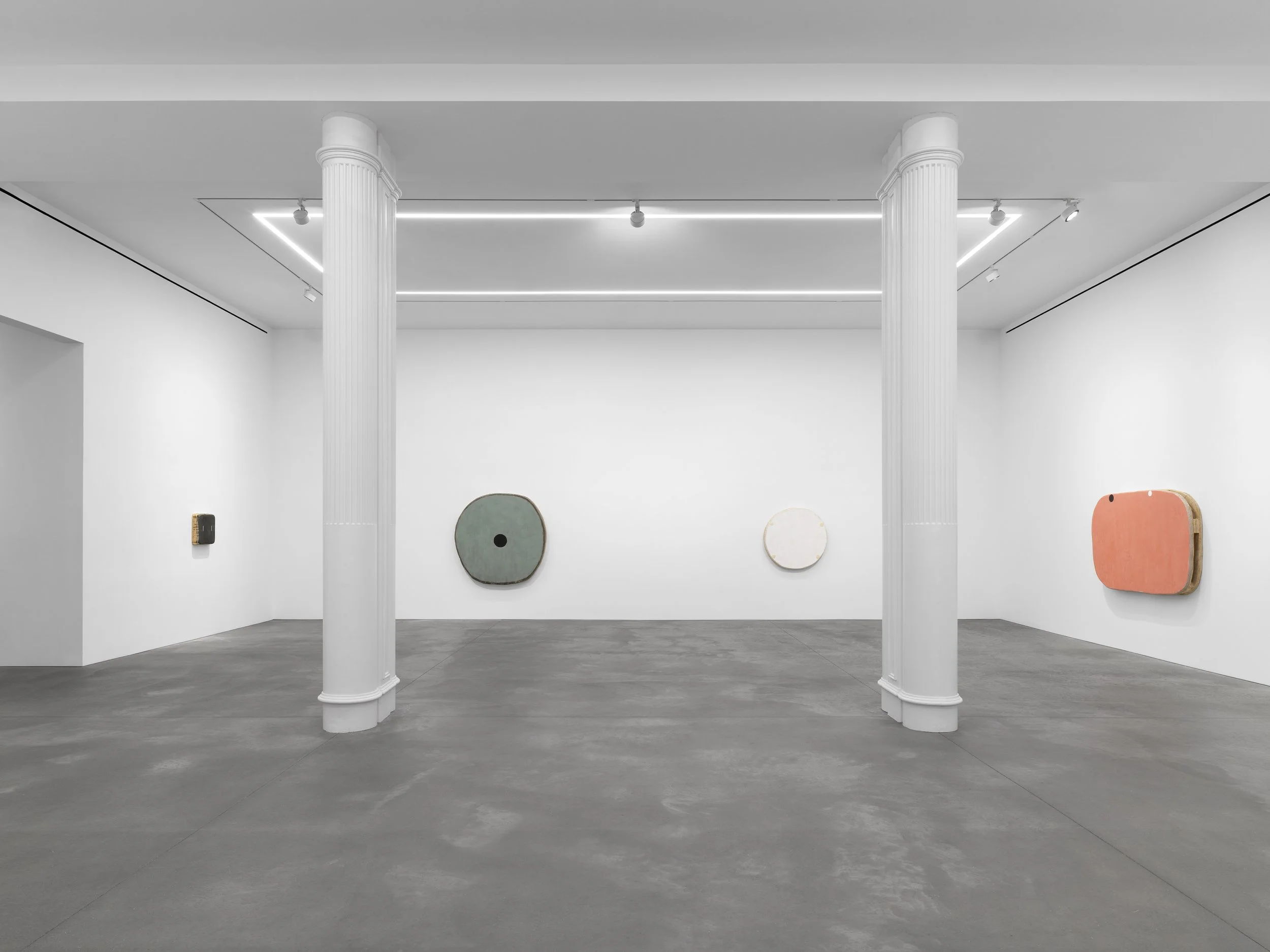Otis Jones:
Echoes in Color
Nino Mier Gallery
May 15 through June 14, 2025
Exhibition Review by Raphy Sarkissian
Installation view of Otis Jones: Recent Work at Nino Mier Gallery, Soho, New York. © Otis Jones. Courtesy of the artist and Nino Mier Gallery. Photo: Erin Brady / Dan Bradica Studio.
The ten absorbing and understated paintings of Otis Jones have transformed the elegant space of Nino Mier Gallery into an ascetic shrine of abstraction. Viewing these seemingly monochromatic paintings up close, however, reveals impalpable traces of underpainting. Whereas Jones's hazy facture gives his surfaces a lyrical quality, the highly distinct and quasi-geometric shapes of these canvases—freeform circles, squares, racetracks, or oblongs—bring to mind Kazimir Malevich’s and El Lissitzky's experimental radicality. These ruminative abstractions of Jones also invoke Henri Bergson’s concept of élan vital, that vital impulse that is continually generating new force. Often sparingly punctuated by notably small circles or bars, the canvases of Jones allure us through their subdued tones and atmospheric evocations. Nostalgia here tinkers with abstraction’s autonomy.
Otis Jones, Red Oxide, With Black and White Circles, 2025. Acrylic on linen on wood, 46.5 by 69.5 by 5.25 inches. © Otis Jones. Courtesy of the artist and Nino Mier Gallery. Photo: Erin Brady / Dan Bradica Studio.
And yet these works' fringes and lateral edges direct our gaze to the painting’s support, revealing surfeits of staples, plywood veneer, and lamination drips. Acting as thresholds, these brinks take on their own presence, partially exposing the painting’s concealed frame and revealing the spaces of the work’s artisanal infrastructure. Spartan yet bodily, these wall-mounted bas-reliefs—handcrafted and hand painted—display affinities with the expressive Minimalism of Agnes Martin, the “specific objects” of Donald Judd, and the surface-support dialectic of Ron Gorchov. With hints of Abstract Expressionism, these paintings of Jones strikingly refashion the canon of Minimalism that fundamentally relied upon “non-art” materials, industrial fabrication, rejection of “the hand,” seriality, and the impersonal. As art critic John Yau has astutely noted, “Jones has taken an abstract, reductive possibility and made something fresh and austerely sensual (or is it sensually austere) out of it.” (1)
Otis Jones, Circle with Three Stacked Circles, Black, Red and White, 2025. Acrylic on canvas on wood, 30 by 30 by 5 inches. © Otis Jones. Courtesy of the artist and Nino Mier Gallery. Photo: Erin Brady / Dan Bradica Studio.
Circle with Three Stacked Circles, Black, Red and White (2025)—the only circular work with a uniform diameter—is an intriguing tondo measuring thirty-inches in diameter and five inches deep. Protruding from the wall, the painting asserts its materiality and objecthood. Yet the surface, evoking weathered stucco in shades of cream white and tan, imparts a feeling of the ethereal. The painting's layered skin is highlighted by an array of three dots in black, red, and white, tangentially aligned on the vertical central axis. Upon opaque and translucent surfaces of layered and sanded paint, the arrangement of dots conveys the sensibilities of Hard-Edge and Op Art. Recalling, for instance, the “Circle Paintings” of Alexander Liberman, executed mainly in the 1950s, Jones’s painting weaves an insightful dialogue between the past and present.
Installation view of Otis Jones: Recent Work at Nino Mier Gallery, Soho, New York. © Otis Jones. Courtesy of the artist and Nino Mier Gallery. Photo: Erin Brady / Dan Bradica Studio.
Art historian E. Luanne McKinnon concludes her perceptive essay on the oeuvre of Jones by noting a sense of “rural reductivism” and how “color arouses timelessness, locales, and other works of art." (2) Through their abstraction, Jones’s chromatically layered paintings prompt the observer to engage in a perpetual exploration of relationships of color: with its sensual skin, Blue with Four Circles, Two Black, Two White (2025) signals at the shades of blue within the sky and river in Johannes Vermeer’s View of Delft, while Red Oxide with Red Circle Black Edge (2023) echoes the coloration of the brick façades of the buildings and architecture. Shaped as dots of color and containing dots of color, these abstractions also come across as conceptual companions of Georges Seurat’s Sunday Afternoon on the Island of La Grande Jatte. Handworked, opaque, and diaphanous, this series of sumptuous paintings of Otis Jones—as if intended to collectively mirror the colors within Paul Cézanne’s Bathers (Les Grandes Baigneuses) of the National Gallery in London—compels us to engage with the rich tapestry of painting’s history and our perceptual reality.
Notes
1. John Yau, “John Yau on Otis Jones,” in Otis Jones (NY: Marc Straus Gallery, 2021), pp. 3-5.
2. E. Luanne McKinnon, “Chop Wood Carry Water, 1983-2019: The Art of Otis Jones,” ibid., pp. 23-29.
Paul Cézanne, Bathers (Les Grandes Baigneuses), ca. 1894-1905. Oil on canvas, 50 by 77.2 inches. Courtesy of the National Gallery, London.
Installation view of Otis Jones: Recent Work at Nino Mier Gallery, Soho, New York. © Otis Jones. Courtesy of the artist and Nino Mier Gallery. Photo: Erin Brady / Dan Bradica Studio.






